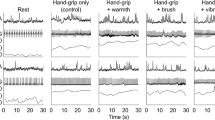Abstract
In 14 healthy female subjects, the effects of needle stimulation (acupuncture) on skin and muscle blood flow were investigated using a non-invasive custom-designed probe and photoplethysmography (PPG). In randomised order, 2–7 days apart, three modes of needle stimulation were performed on the anterior aspect of the tibia: superficial insertion (SF), insertion into the anterior tibial muscle (Mu), and insertion into the muscle including manipulation of the needle in order to elicit a distinct sensation of distension, heaviness or numbness (DeQi). Before intervention, the subjects rested for 30 min. After the intervention, the needle was left in situ for 20 min. Blood flow recordings were performed intermittently from 10 min prior to the intervention to the end of the trial. In a fourth session, serving as control, corresponding measurements were performed without any needle stimulation. Area under curve was calculated for 5-min periods prior to and after stimulation, respectively, and for the remaining 15-min period after stimulation. Compared to the control situation, muscle blood flow increased following both Mu and DeQi for 20 min, with the latter being more pronounced for the initial 5 min. Skin blood flow increased for 5 min following DeQi. However, no increase was found following SF. The DeQi stimulation was preceded by higher visual analogue scale ratings of anxiety prior to stimulation, which might have influenced skin blood flow to some extent. The results indicate that the intensity of the needling is of importance, the DeQi stimulation resulting in the most pronounced increase in both skin and muscle blood flow.




Similar content being viewed by others
References
Altman DG (1999) Practical statistics for medical research. Chapman and Hall/CRC, London, pp 426–433
Andersson S, Lundeberg T (1995) Acupuncture – from empirism to scientific: functional background to acupuncture effects in pain and disease. Med Hypoth 45:271–281
Baldry P (1998) Trigger point acupuncture. In: Filshie J, White A (eds) Medical acupuncture. A Western scientific approach. Churchill Livingstone, Edinburgh, pp 33–60
Blom M, Lundeberg T, Dawidson I, Angmar-Månsson B (1993) Effect of acupuncture on blood flow in patients suffering from xerostomia. Oral Rehabil 30:541–548
Boutouyrie P, Corvisier R, Azizi M, Lemoine D, Laloux B, Hallouin M-C, Laurent S (2001) Effects of acupuncture on radial artery hemodynamics: controlled trials in sensitized and naive subjects. Am J Physiol 280:628–633
Challoner A (1979) Photoelectric plethysmography for estimating cutaneous blood flow. In: Rolfe P (ed) Non-invasive physiological measurements, vol 1. Academic, London, pp 127–151
Cheng X (1987) Chinese acupuncture and moxibustion. Foreign Language Press, Beijing, p 326
Ernst M, Lee M (1986) Sympathetic effects of manual and electrical acupuncture of the Tsusanli knee point: Comparison with the Hoku hand point sympathetic effects. Exp Neurol 94:1-10
Futran ND, Brendan D, Stack C, Hollenbeak C, Scharf JE (2000) Green light photoplethysmography monitoring of free flaps. Arch Otolaryngol Head Neck Surg 126:659–662
Giltvedt J, Sira A, Helme P (1984) Pulsed multifrequency photoplethysmograph. Med Biol Eng Comput 22:212–215
Häbler H-J, Wasner G, Jänig W (1997) Interaction of sympathetic vasoconstriction and antidromic vasodilatation in the control of skin blood flow. Exp Brain Res 113:402–410
Jänig W, Lisney SJW (1989) Small diameter myelinated afferents produce vasodilatation but not plasma extravasation in rat skin. J Physiol (Lond) 415:477–486
Jansen G, Lundeberg T, Samuelson U, Thomas M (1989a) Increased survival of ischaemic musculocutaneous flaps in rats after acupuncture. Acta Physiol Scand 135:555–558
Jansen G, Lundeberg T, Kjartansson J, Samuelsson U (1989b) Acupuncture and sensory neuropeptides increase cutaneous blood flow in rats. Neurosci Lett 97:305–309
Jenkins M (1990) A new standard international nomenclature. Acupunct Med 7:21–23
Kamal A, Harness J, Irving G, Mearns A (1989) Skin photoplethysmography – a review. Comput Meth Prog Biomed 28:257–269
Kashiba H, Ueda Y (1991) Acupuncture to the skin induces release of substance P and gene-related peptide from peripheral terminals of primary neurones in rat. Am J Chin Med 19:189–197
Lindberg LG, Öberg PÅ (1991) Photoplethysmography. Part 2. Influence of light source wavelength. Med Biol Eng Comput 29:48–54
Noguchi E, Ohsawa H, Kobayashi S, Shimura M, Uchida S, Sato Y (1999) The effect of electro-acupuncture stimulation on the muscle blood flow of the hindlimb in anesthetized rats. J Autonom Nerv Syst 75:78–86
Sato A, Sato Y, Schmidt RF (1997) The impact of somatosensory input on autonomic functions. Rev Physiol Biochem Pharmacol 130:1–307
Sato A, Sato Y, Shimura M, Uchida S (2000) Calcitonin gene-related peptide produces skeletal muscle vasodilation following antidromic stimulation of unmyelinated afferents in the dorsal roots in rats. Neurosci Lett 283:137–140
Sugiyama Y, Xue YX, Mano T (1995) Transient increase in human muscle sympathetic nerve activity during manual acupuncture. Jpn J Physiol 45:337–345
Thomas M, Lundeberg T (1994) Importance of modes of acupuncture in the treatment of chronic nociceptive low back pain. Acta Anaesthesiol Scand 38:63–69
Wiederström E, Dyrehag L-E, Börglum-Jensen L, Åslund P, Venneberg B, Andersson S (1998) Pain threshold responses to two different modes of sensory stimulation in patients with orofacial muscular pain: psychological considerations. J Orofac Pain 12:27–34
Willis WD (1999) Dorsal root potentials and dorsal root reflexes: a double-edged sword. Exp Brain Res 124:395–421
Zhang Q, Lindberg LG, Kadefors R, Styf J (2001a) A non-invasive measure of changes in blood flow in the human anterior tibial muscle. Eur J Appl Physiol 84:448–452
Zhang Q, Styf J, Lindberg LG (2001b) Effects of limb elevation and increased intramuscular pressure on human tibialis anterior muscle blood flow. Eur J Appl Physiol 85:567–571
Acknowledgements
The authors want to thank Per Sveider and Bengt Ragnemalm for technical assistance. This work was supported by grants from the County Council in Östergötland, the Foundation for Acupuncture and Alternative Biological Treatment Methods, The Swedish Rheumatism Association and the National Swedish Board for Technical Development (project 98–06659).
Author information
Authors and Affiliations
Corresponding author
Rights and permissions
About this article
Cite this article
Sandberg, M., Lundeberg, T., Lindberg, LG. et al. Effects of acupuncture on skin and muscle blood flow in healthy subjects. Eur J Appl Physiol 90, 114–119 (2003). https://doi.org/10.1007/s00421-003-0825-3
Accepted:
Published:
Issue Date:
DOI: https://doi.org/10.1007/s00421-003-0825-3




